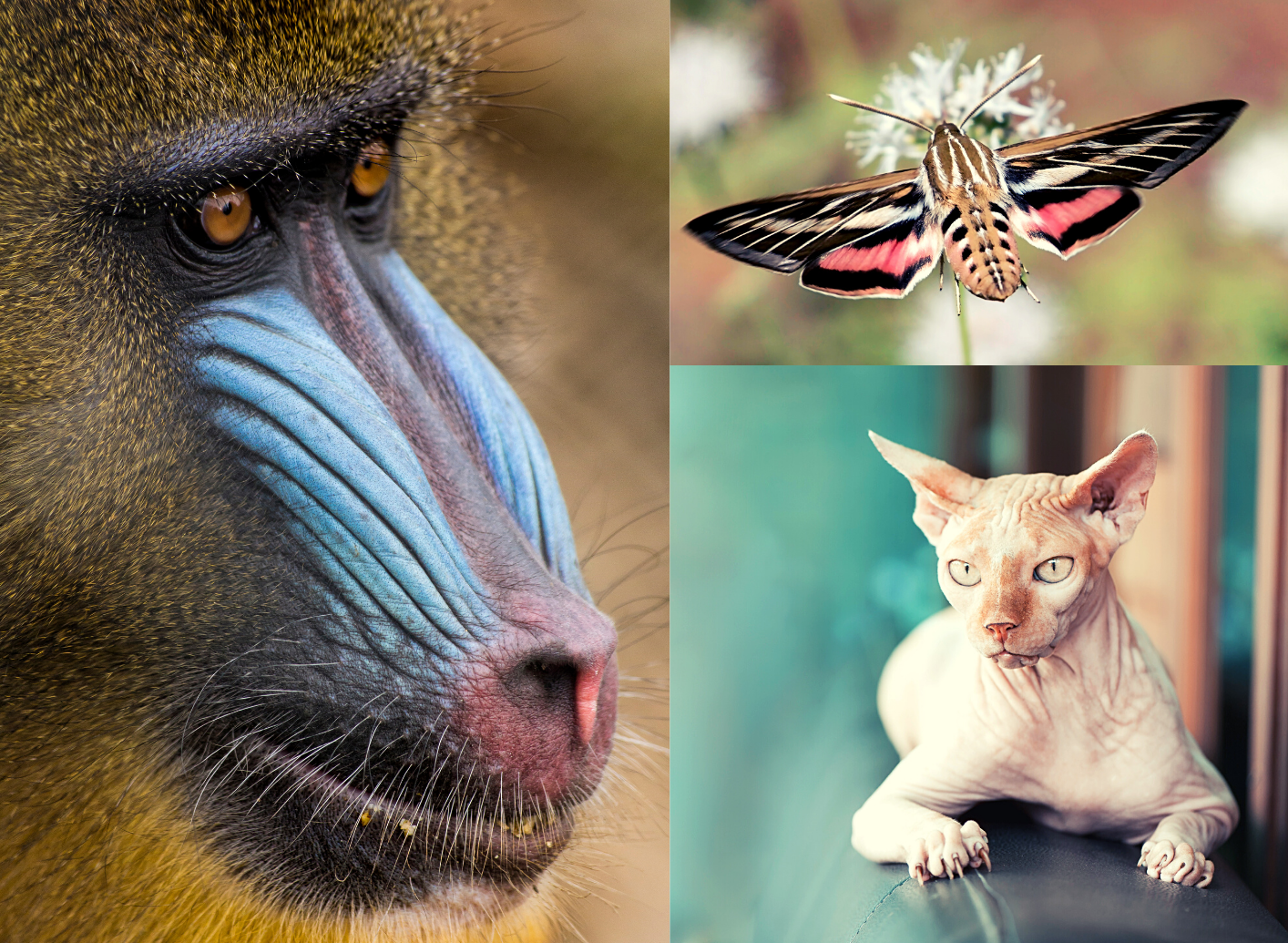The SPHINX
A monument, a yoga pose, a moth, a mandrill and a cat!
A Monument

Finally fully restored and unearthed in the 20th century, one of the most massive monuments in the world came to light and was opened to the public in 1940, the Egyptian Sphinx at Giza.
In the 14th century BC, Prince Tuthmosis, who later became the pharaoh Thutmose IV, embarked on the project to begin the restoration of the Sphinx at Giza by unearthing its head fully. It is said that as he slumbered one night, he dreamt that Ra ordered him to dig out the statue from which he had slept beneath that very night. Then some hundreds of years later, the Great Sphinx was fully excavated and repaired in 1936 and four years later opened to the public in 1940.
Researchers believe the Egyptian monument was built with a ‘divine’ purpose and, its association with the term Sphinx came about nearly 2,000 years after it was built. The Sphinx in ancient Greek mythology is a human-headed lion. The statue’s symbolism is convoluted as it changes through time. Various sources cite links to Hathor, Horus of the Horizon (Hor-em-akhet) and Aker (Akeru or Ruti). Aker is known to protect Ra the Sun God as he entered and exited the underworld. Shrouded in mystery, it has also been theorized that the statue might have represented Anubis, a dog-headed god, at one time.
Hathor
Hathor the sky goddess, also the mother of Ra, was known to help souls in the afterlife. Considered both dangerous and beautiful, Hathor is often drawn as a lioness. She is the goddess of women, of fertility and love.
Horus
Horus an Egyptian god is the son of Osiris and Isis is linked to the early morning sun.
rA
Ra in Egyptian mythology, the sun god, the supreme Egyptian deity, worshipped as the creator of all life and typically portrayed with a falcon's head bearing the solar disc. There are similiarities to Surya the Sun God which you can read more about on the website here.
Even though Hathor and Horus are associated with the Sphinx, inscriptions from the era in which it was constructed refer to a double lion god named Ruti (aka Aker or Akhet). Represented as two lions their names denote yesterday and tomorrow. Each lion sits at the entrance to the underworld guarding the horizon where the Sun rises and sets. Like many other large monuments and pyramids throughout the world, specific solar and cosmic events are linked to the Sphinx and its neighbouring pyramid. They are primarily annual events that relate to the rising and setting sun and the change of seasons.

Ruti (aka Aker or Akhet) Yesterday and Tommorrow
According to Egyptologist Jenny Hill, Aker was Initially depicted as a narrow strip of land with a human or lion head at each end. Later the strip of land was replaced by the hieroglyphic sign meaning “horizon.” In its heyday, it was painted in bright colours; The face and body were red to represent the Sun god Ra, the beard was blue to symbolise the water of the Nile, and the headdress was yellow for the Sun & the desert of Egypt.
Crystallinks article on sphinx myths states that the Egyptian Sphinx holds the keys to the wisdom gates and challenged initiates. That could imply various things and got me thinking. If the Sphinx is the protector of Ra and thereby the Guardian of the Gates of the Underworld, would the wisdom gained come from our own personal descent into the underworld, to the darkness, to the abyss? We don’t constantly want to confront the shadow. However, sometimes we are forced to, even when it isn’t our desire to do so. We journey.

Sphinx pose and Aker
Turns out that Ruti is also known as Aker whose name means “(one) who bends.” Also, Aker’s role included defending the Sun god Ra from the serpent Apep (Apophis). Apep is not to be mistaken for a cobra who in contrast is associated with protection and fertility.
The cobra is often used to depict the Egyptian goddess Wadjet and is related to fertility & the Nile. Wadjet typically doesn’t have anything to do with the Sphinx, except I wanted to mention it since the Sphinx pose is considered a variation of the Cobra pose.
I make a lot of random associations that can lead me down a path at times. Some of the random associations in my brain when thinking about this include:
The cobra is a snake.
The cobra is a symbol of protection.
The cobra is a yoga pose.
The cobra pose is a backbend.
Sphinx pose is a variation of the cobra pose.
Aker is Ruti, who is the Sphinx.
Aker refers to one who bends.
The Sphinx is a yoga pose with a backbend.
Sphinx Pose sometimes called Salamba Bhujangasana
(षलम्ब भुजङ्गासन)
Sphinx pose, a gentle backbend, is a yoga asana (pose) is considered a variation of the cobra. This was a slight surprise to me since when I learned this pose from two different instructors, it was never about that and, it didn’t cross my mind. Looking at it now, of course, that makes sense. For me, when a pose is related to another being, I like to ‘channel’ the feeling or embody it to the best of my ability. In the case of the Sphinx, my imagination brings to mind the pyramids of Egypt and the world-famous Sphinx. It was taught as an active pose.
How to practice Sphinx Pose
The legs are outstretched as the tops of your feet press into the ground.
Hands are face down with the arms bent at the elbows, and the elbows are directly beneath the shoulders.
As your backbends with your hips firmly on the ground, the gaze is directed forward as you push the sternum forward.
Other Creatures, a cat, a moth and a monkey
Still shrouded in mystery, the Sphinx remains a magnificent monument. But that isn’t the only Sphinx in our world. Beyond the mythological ideas of the Sphinx, we have real living and breathing creatures that are named for the Sphinx that grace the planet with their beauty.
Other creatures in our world are named after the Sphinx, including an entire family of moths called Sphingidae. They are commonly identified as sphinx moths, hawk moths, and hornworms and includes about 1,450 species. They are found worldwide. In fact, they visit my balcony garden annually. Moderate to large in size and are distinguished among moths for their rapid, sustained flying ability and can be mistaken for hummingbirds. It inevitably makes me happy when they visit the garden.
Mandrillus sphinx or, a Mandrill is a colourful and primarily ground-dwelling monkey that inhabits the rainforests of equatorial Africa. Stout bodied with a short tail and, with small close-set sunken eyes, you can appreciate how it has come to be known as the Sphinx with its distinguished and very prominent nose and brow. It was formerly classified as a baboon but has since been reclassified as a monkey. Since 1978 the IUCN Red List of Threatened Species has listed the mandrill as a vulnerable species.
Sphynx cat is a new addition to the cat family, this sphynx’s name is spelt differently and, this cat was bred to be hairless.
That sums up an exploration of the Sphinx.

more articles on yoga poses
Don't be a slouch! It's hard to avoid. We may not even realize we are doing it. It's far more common than
Who is Garuda and what is Garudasana?Garuda is a character known as the king of birds in the epic tales Ramayana and Mahabharata. In addition, one of
Goddesses come in all different forms and like a goddess, we can transform Goddess Pose into Spider Pose. Here’s how to do
CobraThe snake, a yoga pose, an effect and symbolismthe snakeThe cobra, like other snakes and serpents, can trigger a primal fear in

